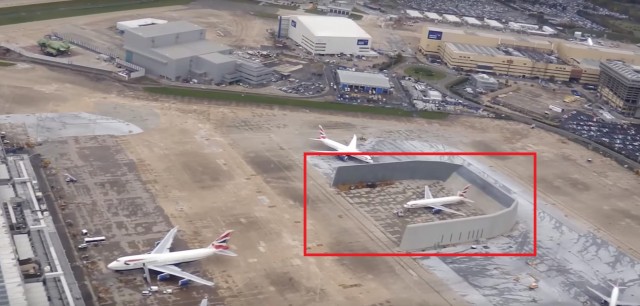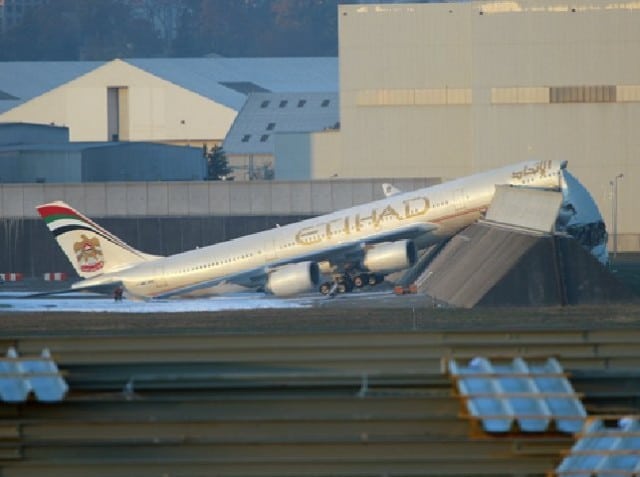Airplane Pens
This is a bit of a short post today to make up for all the heavy posts recently. Me, I’m enjoying the long weekend and a bit of sunshine…

This photograph from Heathrow Airport was posted to Reddit with the question:
What is this plane doing in this enclosed bay?
The correct answer is the top comment:
Probably got new engines, they use enclosures like these to run them up to 110-120% N1 to see if they explode.
Specifically, an aircraft is placed in the pen if the engines need to be run up to full power. This can be new engines, as the poster above mentioned, or for testing, for example for finding an oil leak. The wheels are blocked with chocks and the brakes are put on before the engines are run up to full power.
Another poster used a photograph to demonstrate the importance of the walls:

That photograph is from Toulouse in November 2007, when an Etihad Airbus A340-600 crashed into the walls of its test pen. The investigation discovered that the procedures were not correctly followed and the engines were all operating at high power without wheel chocks. The engine power at full was just beyond the parking brake capacity to hold.
When the Airbus surged forward, the test crew pressed the brake pedals and turned the nose-wheel sharply to the right, leaving the engines at full power. Turning the wheel had the opposite effect of what they wanted: it decreased the brake pressure.
The correct response would have been to reduce the engine thrust immediately.
Meanwhile, the conversation on Reddit about the pen quickly got silly.
If it explodes, it won’t be used on transatlantic trips. Just European routes.
And then there was an alternative explanations:
Was naughty and needs a time out.
And one that took its location and livery into account
It’s the British Airways airplane zoo. The walls are there so it doesn’t escape.
All great answers!
In other news, I’m excited to note that Fear of Landing is now cited as a source on TV Tropes!
Real Life / Schizo Tech – TV Tropes
- By the arrival of year 2016, most countries have global economies, blazingly fast computers, active mars landers, and TV Tropes. Meanwhile, the few uncontacted tribes are so far behind in technology that both sides of the Trojan War (~1190 BC) would consider them primitive. Just a couple years prior, an anthropologist’s plane got too close to Sentinel Island and had a hundred or so arrows put in it
 . Not surprisingly, the anthropologists agreed that they would remain uncontacted.
. Not surprisingly, the anthropologists agreed that they would remain uncontacted.
That links to my article debunking the myth (the aircraft in question was part of an art display).
Pretty cool, huh?
Have a great weekend and I’ll see you all here again next week.









“Meanwhile, the conversation on Reddit about the pen quickly got silly.”
That’s nature of reddit! The conversation always gets silly! :D
Very true! I’m usually banned from visiting on a Friday as I’ll spend all day reading and never finish my blog post! :)
These pens have an additional function, apart from pure safety issues: They also reduce the noise impact on surrounding buildings, be they residential or commercial. It also deviates the blast from engines running at full power, which can easily blow away a vehicle behind them. So without a pen, or blast fence, service roads must otherwise be kept at a safe distance.
Chocks will not always prevent what happened to the Etihad A340.
I remember what happened during my route training on a Learjet 25: The engines had been started, we were ready to taxi but the ground crew had left to attend to another departing aircraft, a Falcon 20. The chocks were still in place. So here we were, sitting at the ramp, taxi clearance obtained but nobody around to remove the chocks. The cockpit windows of the 20-series Lear are thick, curved and small. Waving did not attract attention. Rather than shutting one down, opening the door and removing the chocks ourselves the training captain told me to release the brakes and open the taps. The main wheels just lifted themselves out of the chocks; the Lear did indeed have a lot of excess power. Even in tropics, we could count on an initial climb rate of more than 5000 fpm, 8000 if necessary, and it could keep that up until well past FL 250; as soon as airborne we had to throttle back or we would exceed the VNE.
Yes, an exciting aircraft to fly but it did not like low altitudes. On internal flights in Germany, the maximum permissible was FL 250 and at those altitudes the Lear would go through the Jet A1 like a …. in a ……; well – fill in the rest yourself, my version is not “PC”.
Jet blast can be very dangerous if not contained by a pen or some sort of fencing. Once, at Milan Malpensa, we had a Citation parked near the buildings in order to complete customs formalities when an Alitalia B747 missed the turn to a taxiway. The crew tried to correct their error by attempting to make a 360 on the taxiway alongside the part of the apron where we were parked. In order to tighten the turn, they opened the engines on the outside of the turn to full power. The blast hit the Citation broadside-on and came very, very close to blowing our little bizjet into the terminal building. I ran back, jumped into the aircraft, turned on the radio and overrode all other transmissions with a “Break-break Altitalia 747 I-DEMA cut power immediately….” Fortunately it was all understood in time to avert a little catastrophe
The 747 had to call in the towing truck but nothing worse happened.
So those pens are there for a good reason.
And, btw, jet engines are designed to run on “100%” power or more (something a mathematician finds difficult to understand) all day long.
Structural failures are, fortunately, extremely rare.
The engines are run up to maximum power not just to see if they will – or will not – explode but also to check that oil- or other seals will be tight, including accessories. But a very important part is the calibration process: to verify that the engine performance criteria are met and that temperatures etc. will remain within required parameters.
PS Sylvia, have a nice holiday.
Oh, when I was first rated on jets I asked the engineers how an engine can run at more than 100%. After all, 100% is, well, 100%. The sum total so to speak.
The answer was that the 100% (fan speed) had been determined during the final development phase of the engine.
The Citations were rated to operated at increasingly high altitudes. If I remember correctly, the initially certified maximum was FL 350. When I flew the C500 it was called “Citation I”, had improved engines and an increased wing span and a few other improvements. It was certified to FL 410.
In the decreasing air density, the engines were allowed to operate at higher fan speeds. There was a quick reference table provided which gave the crew the allowable power (fan) setting.
Again, from memory, I think that the C500’s P&W JT15 would be allowed to go to 102.1%, the 550 (Citation II) even to 104%.
These fan speeds would be maintained during the ENTIRE cruise.
Anyway, this is the explanation as given by the engineers.
The jet engine is a different “animal” from a piston one. It does not “explode” because of a higher RPM, as long as the parameters are set to correspond to the allowable.
And as a result, they do not “strain” at high altitudes. The regional jet , subject of another of Sylvia’s thought-provoking articles, that lost both engines when the crew tried to find out how high they could go probably suffered a flame-out due to compressor stall. At too high an angle of attack, and probably too low a speed, the airflow over the compressor and fan blades must have broken up. In such a case, the engines will not re-start easily and the engines may even burn out when the crew tries.
BTW an important detail:
The “pen” at LHR is part of the B.A. maintenance base.
This is not a manufacturing testing area and engines will NOT be tested beyond certain limits there. These engines are very, very, very expensive. Destructive testing will be confined to the engine manufacturers. I do not think that Mr, Willie Walsh will be very pleased if an engine is tested to destruction and he sees the bill. And I wonder if the insurance will cover it if the limits were exceeded deliberately.
An exploding engine often, if not usually, will damage a lot more. Ruptured hydraulic- and fuel lines, an airframe that looks like it was hit by shrapnel, all expensive repairs. It will make the Comanche with all the arrows look pristine in comparison.
There will, no doubt, be tables for engineers giving exact (maximum) permissible settings for a test run. The maximum will depend on temperature and altimeter setting and if going beyond a certain limit at all, I would not be surprised if that will be confined to a time limit.
I was thinking the same as Rudy Jakma: “These pens have an additional function, apart from pure safety issues: They also reduce the noise impact on surrounding buildings, be they residential or commercial. It also deviates the blast from engines running at full power, which can easily blow away” anything behind them. Great article and photos. Thanks. Sylvia.